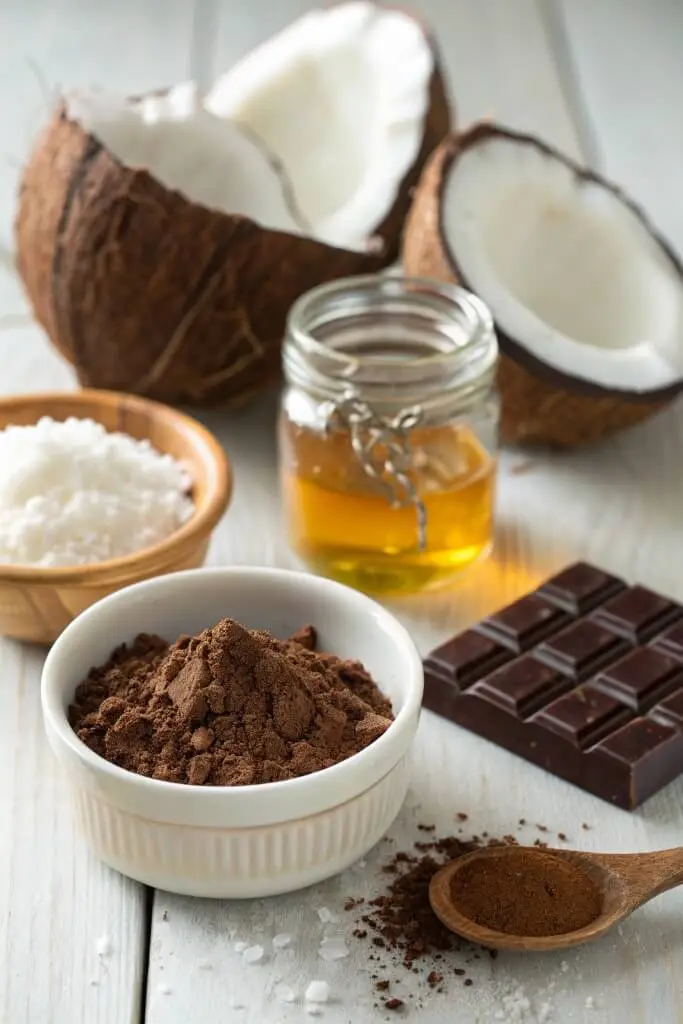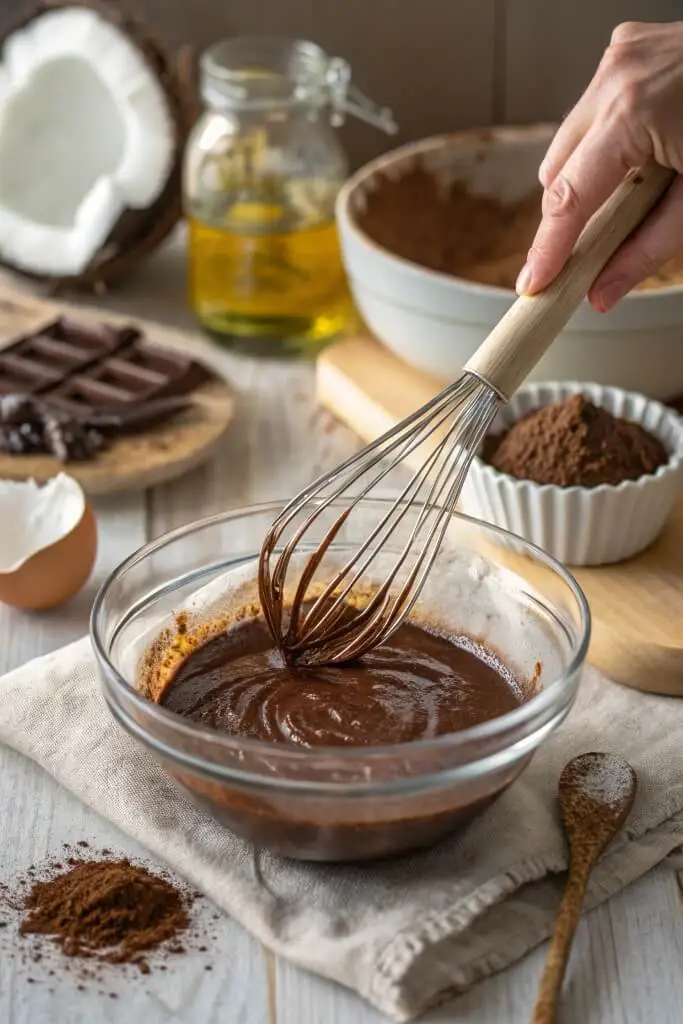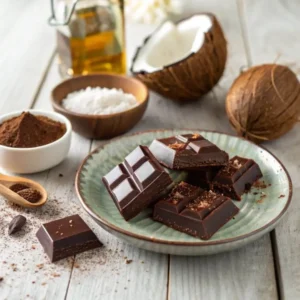Have you ever craved rich, velvety chocolate but wished for a healthier alternative? This coconut oil cocoa chocolate recipe is the perfect balance of indulgence and nourishment. Made with wholesome ingredients, it delivers the deep, satisfying taste of chocolate while offering the natural benefits of coconut oil and antioxidant-rich cocoa.
Whether you’re looking for a dairy-free treat, a quick homemade chocolate fix, or a way to customize flavors with nuts and sweeteners, this recipe has you covered. Plus, it’s incredibly easy to make—no fancy equipment needed! Get ready to create a smooth, melt-in-your-mouth chocolate that’s as good for you as it is delicious.
Table of Contents
Key Benefits of Coconut Oil Cocoa Chocolate
Why choose coconut oil cocoa chocolate over store-bought varieties? Aside from its rich, decadent taste, this homemade treat offers several health and culinary advantages. Here’s why you’ll love making it yourself:
1. Healthier Alternative to Traditional Chocolate
- Coconut oil contains healthy fats that can support metabolism and provide quick energy.
- Cocoa powder is packed with antioxidants that may promote heart health and reduce inflammation.
- You control the sweetener, making it a great option for sugar-free or low-carb diets.
2. Naturally Dairy-Free & Vegan-Friendly
- Unlike commercial chocolate, this recipe requires no milk or cream, making it perfect for lactose-intolerant individuals and those following a vegan diet.
3. Easy to Customize for Your Taste
- Adjust the sweetness with honey, maple syrup, or a keto-friendly alternative like stevia.
- Mix in nuts, sea salt, dried fruit, or vanilla extract for added texture and flavor.
- Create different variations, from dark chocolate to a lightly sweetened milk-style version.
4. Quick & Simple to Make
- With just a few basic ingredients and a melt-and-pour method, this recipe is beginner-friendly and takes less than 10 minutes to prepare.
5. Melts Smoothly & Stores Well
- Coconut oil gives the chocolate a silky-smooth texture that melts beautifully in your mouth.
- Store it in the fridge or freezer for a quick, satisfying treat anytime.
Making your own coconut oil cocoa chocolate means enjoying a treat that’s delicious, nourishing, and perfectly tailored to your preferences—all in the comfort of your kitchen! Ready to get started? Let’s dive into the ingredients you’ll need.
Ingredients for Coconut Oil Cocoa Chocolate

Before diving into the process, let’s gather everything you’ll need. This simple yet versatile ingredient list ensures a smooth, rich chocolate with the perfect balance of flavor and texture.
Essential Ingredients:
- ½ cup coconut oil (unrefined for a subtle coconut flavor or refined for a neutral taste)
- ½ cup cocoa powder (unsweetened, high-quality for the best flavor)
- 3–4 tbsp sweetener (honey, maple syrup, or a sugar-free option like stevia or monk fruit)
- 1 tsp vanilla extract (for added depth and aroma)
- Pinch of sea salt (enhances the chocolate’s richness)
Optional Add-Ins:
- Chopped nuts (almonds, walnuts, or hazelnuts for crunch)
- Dried fruit (cranberries, raisins, or coconut flakes for a natural sweetness)
- Spices (cinnamon or cayenne for a warm or spicy twist)
- Espresso powder (a pinch to intensify the chocolate flavor)
Equipment You’ll Need:
- Double boiler (or a heatproof bowl over a saucepan)
- Whisk or spoon (for smooth mixing)
- Chocolate molds or a parchment-lined tray (for setting the chocolate)
With these ingredients on hand, you’re ready to create a homemade chocolate that’s indulgent, wholesome, and completely customizable. Now, let’s walk through the simple steps to bring it all together!
How to Make Coconut Oil Cocoa Chocolate

Now that you’ve got all your ingredients ready, let’s get into the fun part—making this delicious coconut oil cocoa chocolate! With just a few simple steps, you’ll have a homemade chocolate treat that’s smooth, rich, and satisfying. Here’s how to do it:
Step 1: Melt the Coconut Oil
- Start by placing your coconut oil in a heatproof bowl.
- If you’re using a double boiler, fill the bottom pot with a bit of water and bring it to a gentle simmer. Then, place the bowl with coconut oil on top, ensuring it doesn’t touch the water. Stir occasionally until the oil is fully melted.
- Alternatively, you can melt the coconut oil in the microwave by heating it in 20-30 second intervals, stirring in between.
Step 2: Whisk in the Cocoa Powder
- Once the coconut oil has melted, add your unsweetened cocoa powder to the bowl.
- Use a whisk or spoon to blend the two together until smooth. The cocoa powder will dissolve easily, creating a velvety base for your chocolate.
- For extra flavor, you can add vanilla extract and a pinch of sea salt at this stage. The salt will enhance the natural bitterness of the cocoa, making it taste even richer.
Step 3: Sweeten the Chocolate
- Stir in your sweetener of choice (honey, maple syrup, stevia, or monk fruit). Adjust the sweetness to your liking, but keep in mind that a little goes a long way, especially if you’re using a more concentrated sweetener like stevia.
- Mix well to ensure the sweetener is fully incorporated into the chocolate.
Step 4: Add Optional Mix-ins
- If you’d like to customize your chocolate, now’s the time to add any nuts, dried fruit, or spices.
- Chopped almonds or walnuts add a delightful crunch, while dried cranberries or coconut flakes provide natural sweetness and chew. If you like a bit of heat, a dash of cinnamon or cayenne can create a flavorful twist.
Step 5: Pour and Set
- Once everything is well mixed, pour the chocolate mixture into chocolate molds or onto a parchment-lined tray to form a flat chocolate sheet.
- Use a spoon to smooth the top if needed. You can also sprinkle a little extra sea salt or crushed nuts on top for added texture and flavor.
Step 6: Chill and Enjoy
- Place your molds or tray in the fridge for about 1-2 hours, or until the chocolate has completely set and firmed up.
- Once ready, carefully remove the chocolate from the molds or break it into pieces if you used a tray.
- For the best texture, store your homemade chocolate in the fridge or freezer, especially if you’re in a warmer climate, as coconut oil melts at a lower temperature than other oils.
There you have it! A batch of rich and creamy coconut oil cocoa chocolate that’s as easy to make as it is satisfying to eat. Ready to enjoy your creation?
Pro Tips and Variations for Coconut Oil Cocoa Chocolate
Now that you’ve mastered the basics of making coconut oil cocoa chocolate, let’s take things to the next level with some pro tips and fun variations. These small tweaks can make your chocolate even more delicious and allow you to customize it to suit your tastes.
Pro Tips for Perfect Chocolate
- Temperature matters: To get that perfect smooth texture, be sure not to overheat your coconut oil. Melting it gently ensures it blends seamlessly with the cocoa powder. If using a microwave, go slow with 20-second bursts to avoid overheating.
- Mix thoroughly: To prevent the cocoa powder from clumping, make sure to whisk it thoroughly into the melted coconut oil. This ensures your chocolate is silky and free of lumps.
- Don’t skip the sea salt: A tiny pinch of sea salt enhances the chocolate’s flavor and balances out the sweetness. It’s a simple step that makes a huge difference!
Flavor Variations to Try
- Nutty Delight: Add chopped almonds, hazelnuts, or walnuts for a crunchy texture. For extra flavor, toast the nuts lightly before mixing them in.
- Coconut-Lover’s Dream: If you love coconut, mix in shredded coconut or even a touch of coconut extract to elevate the tropical flavor.
- Fruity Twist: Dried fruits like cranberries, raisins, or chopped dried apricots add a natural sweetness and chewy texture to each bite.
- Spiced Chocolate: For a cozy, warm version, sprinkle in some cinnamon, cardamom, or a pinch of cayenne pepper for a spicy kick.
- Keto-friendly Chocolate: If you’re following a keto diet, opt for a sugar substitute like erythritol or monk fruit to keep it low-carb without sacrificing sweetness.
Storing and Serving Tips
- Storage: Because this chocolate is made with coconut oil, it’s best to store it in the fridge or freezer to maintain its solid texture. You can store it for up to 2 weeks in the fridge or longer in the freezer.
- Serving Suggestions: Break the chocolate into pieces and serve as a treat after dinner, or melt it over fruit like strawberries or banana slices for a decadent dessert.
- Gifting: This homemade chocolate also makes a lovely gift. Simply pour it into cute molds or shape it into small bars, wrap it in parchment paper, and tie it with a ribbon. Perfect for special occasions or a thoughtful, edible gift.
With these simple pro tips and creative variations, you can make your coconut oil cocoa chocolate even more irresistible and tailored to your taste. Have fun experimenting and savor every bite!
Serving Suggestions for Coconut Oil Cocoa Chocolate
Now that you’ve made your coconut oil cocoa chocolate, it’s time to get creative with how you serve and enjoy it! Whether you’re treating yourself or sharing with others, here are some fun, delicious ways to serve your homemade chocolate.
1. Enjoy it as a Simple Snack
Sometimes, the best way to enjoy chocolate is just as it is! Break your chocolate into bite-sized pieces and savor the rich, velvety flavor. It’s a perfect snack when you need a quick energy boost or a little sweet indulgence.
2. Pair with Fresh Fruit
The deep cocoa flavor pairs beautifully with fresh fruit. Try serving your chocolate with slices of strawberries, bananas, or apples. The combination of creamy chocolate and juicy, fresh fruit is irresistible! You can also dip the fruit directly into melted chocolate for an extra indulgent treat.
3. Top Your Favorite Desserts
Craving a decadent dessert? Drizzle your homemade coconut oil cocoa chocolate over ice cream, yogurt, or chia pudding for a rich, chocolatey topping. It adds a delightful texture and elevates any dessert.
4. Add to Breakfast
Why not enjoy chocolate at breakfast? Break a few pieces of your homemade chocolate over a bowl of oatmeal, granola, or smoothie bowls. The combination of chocolate and wholesome ingredients makes for a fun and energizing start to your day.
5. Make Chocolate Bark
Spread your cooled chocolate mixture over a parchment-lined baking sheet and top with an assortment of your favorite ingredients—think dried fruit, seeds, or crushed nuts. Once it hardens, break it into shards to create your own chocolate bark. It’s perfect for sharing or gifting!
6. Gift It
Homemade chocolate is always a thoughtful gift! Pour your mixture into chocolate molds or form it into bars, and package it in cute gift boxes or wrapping. It’s a personal, homemade treat that friends and family will love.
7. Perfect for Parties and Gatherings
If you’re hosting a gathering, consider using your homemade chocolate as a part of a dessert platter. Serve it alongside other treats like cookies, brownies, or marshmallows for a chocolate lover’s dream spread.
With these simple serving suggestions, your coconut oil cocoa chocolate will be the star of any occasion, whether you’re indulging solo or sharing with friends. Let your creativity shine and enjoy!
Conclusion: Why You’ll Love Coconut Oil Cocoa Chocolate
There’s no denying it—coconut oil cocoa chocolate is an absolute game changer. Whether you’re a chocolate enthusiast or simply looking for a healthier, customizable treat, this homemade chocolate delivers both flavor and benefits without any of the guilt.
From the antioxidant-packed cocoa to the healthy fats in coconut oil, you’re indulging in something that not only tastes amazing but also nourishes your body. Plus, with the ability to personalize your chocolate with a variety of mix-ins and sweeteners, it’s easy to make this recipe suit your dietary preferences and taste buds perfectly.
Making chocolate at home is fun, straightforward, and incredibly rewarding. With just a few simple ingredients, you can create a batch of creamy, melt-in-your-mouth chocolate that’s both indulgent and wholesome. Whether you enjoy it on its own, paired with fruit, or as a topping for desserts, there’s no wrong way to enjoy this treat!
So, go ahead and give it a try. With this easy, flexible recipe, you can savor delicious chocolate that’s good for you too! Enjoy every bite, and don’t forget to share it with friends and family—because a homemade treat like this deserves to be enjoyed by everyone.

Coconut Oil Cocoa Chocolate
Ingredients
Essential Ingredients:
- ½ cup coconut oil unrefined for a subtle coconut flavor or refined for a neutral taste
- ½ cup cocoa powder unsweetened, high-quality for the best flavor
- 3 –4 tbsp sweetener honey, maple syrup, or a sugar-free option like stevia or monk fruit
- 1 tsp vanilla extract for added depth and aroma
- Pinch of sea salt enhances the chocolate’s richness
Optional Add-Ins:
- Chopped nuts almonds, walnuts, or hazelnuts for crunch
- Dried fruit cranberries, raisins, or coconut flakes for a natural sweetness
- Spices cinnamon or cayenne for a warm or spicy twist
- Espresso powder a pinch to intensify the chocolate flavor
Equipment You’ll Need:
- Double boiler or a heatproof bowl over a saucepan
- Whisk or spoon for smooth mixing
- Chocolate molds or a parchment-lined tray for setting the chocolate
Instructions
Step 1: Melt the Coconut Oil
- Start by placing your coconut oil in a heatproof bowl.
- If you’re using a double boiler, fill the bottom pot with a bit of water and bring it to a gentle simmer. Then, place the bowl with coconut oil on top, ensuring it doesn’t touch the water. Stir occasionally until the oil is fully melted.
- Alternatively, you can melt the coconut oil in the microwave by heating it in 20-30 second intervals, stirring in between.
Step 2: Whisk in the Cocoa Powder
- Once the coconut oil has melted, add your unsweetened cocoa powder to the bowl.
- Use a whisk or spoon to blend the two together until smooth. The cocoa powder will dissolve easily, creating a velvety base for your chocolate.
- For extra flavor, you can add vanilla extract and a pinch of sea salt at this stage. The salt will enhance the natural bitterness of the cocoa, making it taste even richer.
Step 3: Sweeten the Chocolate
- Stir in your sweetener of choice (honey, maple syrup, stevia, or monk fruit). Adjust the sweetness to your liking, but keep in mind that a little goes a long way, especially if you’re using a more concentrated sweetener like stevia.
- Mix well to ensure the sweetener is fully incorporated into the chocolate.
Step 4: Add Optional Mix-ins
- If you’d like to customize your chocolate, now’s the time to add any nuts, dried fruit, or spices.
- Chopped almonds or walnuts add a delightful crunch, while dried cranberries or coconut flakes provide natural sweetness and chew. If you like a bit of heat, a dash of cinnamon or cayenne can create a flavorful twist.
Step 5: Pour and Set
- Once everything is well mixed, pour the chocolate mixture into chocolate molds or onto a parchment-lined tray to form a flat chocolate sheet.
- Use a spoon to smooth the top if needed. You can also sprinkle a little extra sea salt or crushed nuts on top for added texture and flavor.
Step 6: Chill and Enjoy
- Place your molds or tray in the fridge for about 1-2 hours, or until the chocolate has completely set and firmed up.
- Once ready, carefully remove the chocolate from the molds or break it into pieces if you used a tray.
- For the best texture, store your homemade chocolate in the fridge or freezer, especially if you’re in a warmer climate, as coconut oil melts at a lower temperature than other oils.
Video
Notes
- Prep Time: 10 minutes
- Cook Time: 5 minutes
- Total Time: 15 minutes
- Servings: 12 pieces (can vary depending on portion size)
- Calories: 150 per serving (approx.)
FAQs About Coconut Oil Cocoa Chocolate
Here are answers to some of the most common questions about making and enjoying coconut oil cocoa chocolate. Whether you’re a first-time maker or looking to refine your skills, these insights will help you get the most out of your homemade chocolate.
1. What is coconut oil cocoa chocolate?
Coconut oil cocoa chocolate is a homemade, healthier chocolate made with just a few simple ingredients: coconut oil, cocoa powder, and sweetener. It’s a rich, creamy treat that you can customize with mix-ins like nuts, dried fruit, or spices. It’s perfect for those looking for a dairy-free, vegan, or healthier chocolate option.
2. Can I use any type of coconut oil for coconut oil cocoa chocolate?
Yes, you can use either refined or unrefined coconut oil for making coconut oil cocoa chocolate. Refined coconut oil has a neutral flavor, while unrefined has a light coconut taste that enhances the overall flavor of your chocolate. The choice depends on your taste preferences!
3. How do I sweeten coconut oil cocoa chocolate?
You can sweeten coconut oil cocoa chocolate with a variety of options like honey, maple syrup, or even sugar-free sweeteners like stevia or monk fruit. Adjust the sweetness based on your personal preference, but be mindful that some sweeteners are sweeter than others, so use less if you’re using a concentrated option.
4. Can I make coconut oil cocoa chocolate without cocoa powder?
No, cocoa powder is essential for creating the rich flavor of coconut oil cocoa chocolate. However, you could experiment with raw cacao powder for a more intense chocolate flavor or carob powder for a milder, slightly sweeter taste.
5. How do I store coconut oil cocoa chocolate?
To maintain the texture and consistency of your coconut oil cocoa chocolate, it’s best to store it in the fridge or freezer. Coconut oil melts at a low temperature, so keeping it cold will help the chocolate stay firm and ready for indulgence whenever you want it.
6. Can I use coconut oil cocoa chocolate in other recipes?
Absolutely! You can melt coconut oil cocoa chocolate and use it as a drizzle over desserts like ice cream or pancakes, or as a dip for fruits like strawberries or bananas. It also works as a base for chocolate bark when you add your favorite mix-ins.
7. Is coconut oil cocoa chocolate vegan?
Yes, coconut oil cocoa chocolate is naturally vegan as long as you use plant-based sweeteners and avoid dairy ingredients. The combination of coconut oil and cocoa powder is a rich, plant-based treat perfect for anyone following a vegan diet.
8. How can I make coconut oil cocoa chocolate more creamy?
For a creamier texture, try adding a tablespoon of coconut milk or almond milk to your coconut oil cocoa chocolate. This will give the chocolate a smoother, more luxurious mouthfeel without altering the flavor too much.
9. Can I add nuts to coconut oil cocoa chocolate?
Yes, adding chopped nuts like almonds, walnuts, or hazelnuts to coconut oil cocoa chocolate is a great way to add crunch and texture. Simply stir them into the chocolate mixture before setting it in molds or a tray. You can also sprinkle some on top for extra flair.
10. How long does coconut oil cocoa chocolate last?
Coconut oil cocoa chocolate can last up to two weeks in the fridge when stored in an airtight container. If you prefer it firmer, keep it in the freezer for up to a month. Just be sure to allow it to come to room temperature for a minute or two before eating if it’s been stored in the freezer.
These answers should help you make the most of your coconut oil cocoa chocolate experience, whether you’re crafting your first batch or enjoying it in a variety of ways!
Looking for more guilt-free treats? Explore our collection of healthy chocolate recipes and indulge without the worry!


1 thought on “Coconut Oil Cocoa Chocolate”